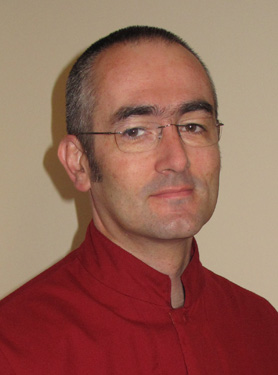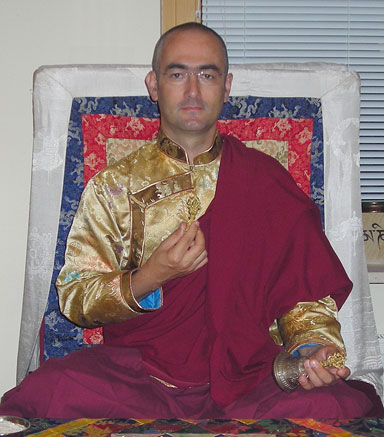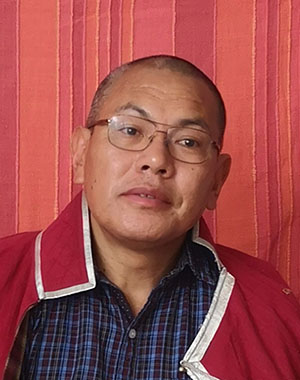- fBecome a fan on Facebook

Main Teacher - Lama Shenphen Rinpoche

Lama Shenpen Rinpoche was born in Western France. Very early in his life - during and right after his birth - various special signs manifested. As a young child, Rinpoche was surprisingly interested in philosophical concepts, for example reincarnation. Around 12 and 13 years of age, Rinpoche had some visions of his previous life, of landscape, mountains - of what was later recognized as his monastery in Tibet.
But Rinpoche really engaged in Buddhism at the age of 16, when a Tibetan Lama came to his town (Lama Gendun Rinpoche from the Kagyu tradition). After some teachings, Rinpoche went to Nalanda Monastery (close to Toulouse - France). When Rinpoche saw some men dressed as Tibetan monks He was "full of joy". In a way, He was feeling back home. This was in April 1985.
Almost the same day, an important Lama arrived at Nalanda too: Gomo Tulku. It was during an appointment that Gomo Tulku explained to Rinpoche-la the meaning of the visions he had when he was younger, telling him that he was the rebirth "of a great practitioner in Tibet". Which was later, after 1992, confirmed by several Lamas, melong-readers, and an Oracle in Dharamsala. Finally the Kharnang Monastery officially recognised Lama Shenphen Rinpoche as the Tulku of Lama Gendun Rabgye (here the letters from Kharnang monastery and Sera-Jhe Lhadrel Khangtsen). The official ceremony at the Kharnang Monastery couldn't be performed right away, as the place is remote (in Tibet), individual travelling to Tibet was not possible, and there were various political considerations. The formal enthronement was finally performed in July 2003.
Two years later when Rinpoche went to the Sera Jey Monastery, the ceremony of enthronement could also be performed at the Sera Jey Monastery, in Jadrel Khamtsen.
Back in 1990, being 21 years old, Rinpoche took the full monk ordination with His Holiness the Dalai Lama in Dharamsala.
During the following five years, Shenphen Tulku remained engaged into different social and humanitarian actions. "Titles are words which can be quite empty. We can judge a tree by the fruits it produces. To learn about and later to teach Compassion, humility and such, is very nice, but one should also find ways to practice all this!" says Rinpoche.
Between 1998 & 2001, following the request of Kyabje Zopa Rinpoche, Spiritual Director of the Foundation for the Preservation of the Mahayana Tradition (FPMT), Shenphen Rinpoche was the director of a retreat Centre in Greece. Then, Rinpoche went to Spain, to open a small Dharma Center, and remained there till 2002.
Since the year 2000, Rinpoche teaches regularly in several other countries, for example Austria, Hungary, Russia, Spain, Romania, Switzerland, France, Tibet, and India, ...
In September 2002, Lama Shenpen Rinpoche arrived in Slovenia. The "Tibetan Buddhist Congregation - Dharmaling" was registered with the Government in 2003, with Rinpoche as its Abbot. In May 2008, following the advises of a melong-reading-Rinpoche, Shenphen Rinpoche left his ordination and accepted to continue His work as lay Lama.
Being also a renowned healer, Rinpoche is receiving people for this purpose and also private appointments all along the week.
In January 2007, the main Center in Slovenia has been opened (which is also the only consecrated Buddhist Temple in the country).
In July 2008, Dharmaling has signed a special agreement with the State of Slovenia, and became the sixth religious community to do so in the country after the Christian Churches and the main Muslim Community.

An accomplished Teacher and practitioner, Shenpen Rinpoche is showing the Path of integration for the Buddhist practice and the daily life:
"The goal of Buddha's Teachings is not any kind of selfish satisfaction but a state of mind we call 'Awakening'. This goal is achieved only if one has a heart Compassionate enough and a Wisdom sharp enough. We are sleeping in our material world, relying on our senses as if what they are telling us is an unchallengeable Truth. We have a ‘monkey-mind’, always jumping from one thought to another, which prevents us from correctly perceiving our reality. We need to understand how our mind works, and how to drive it correctly."
"Once you drive your own mind, you start to see things as they truly are, and not as you are told to see them, by the education system, by the society, by religions which aim to ceaselessly amass more wealth and power, by the media, etc. Then you start to be a responsible being, able to express the full potential of a human life and to climb the steps toward Liberation from this conditioned existence."
"Nowadays, it is very important that many people can integrate the main human and spiritual values into their everyday life, into their work, into their family, into their public and private lives. In this world of chaos, the result of our disturbed mind, we have to find again the values of Peace, of Loving kindness, of altruism. Old religious rituals, embedded with local cultures, are not that important anymore. What matters is that people can open their eyes, see the true nature of the reality they are living in, understand the universal law of causality and become fully responsible of what they are doing, of their motivation and of the consequences of all actions of body, speech, and mind. Only then they will live as responsible beings, caring for each other and for their environment."
More information about the process and recognition of Rinpoche
More about Lama Shenpen Rinpoche?
Facebook: Shenpen Rinpoche
Make a donation to support Lama Shenpen Rinpoche's activities:
Visiting Teachers
Gomo Tulku Rinpoche
A Tibetan, Canadian, American. Lama, musician, entrepreneur. Gomo Tulku’s philosophy towards living, learning and teaching Buddhism is one with a strong emphasis on authenticity, relevance and pragmatism – an approach that is evident in the young Rinpoche’s life and career choices so far as he traverses the universes of North America, Europe and Asia. Gomo Tulku’s life in his 23rd incarnation began in Montreal, Canada, on August 8th, 1988. He was recognized at the age of three by His Holiness the 14th Dalai Lama, as the reincarnation of his maternal grandfather, the 22nd Gomo Tulku. Capturing the public's interest, Gomo Tulku's story was featured on multiple international media outlets, including the Oprah Winfrey Show in the US and major news agencies, such as Rai Italia.
Ordained as a monk by the Dalai Lama in 1995 at Lama Tzong Khapa Institute, in Pomaia, Italy, Gomo Tulku spent his following 12 years in traditional monastic education at Sera Jey Monastic University, India, where he studied Buddhist philosophy and Buddhist psychology. In August 2008, he graduated with honors following a ceremony called Rig-Chung, which involved a rigorous scholastic debate in front of thousands of monks.
Like the previous Gomo Tulku, who had the full Geluk lineage, and who was renowned for his expertise in Buddhist philosophy and tantra practice as well as traditional chants and ritual dance, Gomo Tulku discovered his parallel passion in music and dance at a young age. After completing his foundational education in Buddhism, Gomo Tulku left formal monastic life to pursue his musical career in Europe. His debut album was produced in collaboration with internationally reputed producers and musicians, including Deleterio and Jidenna, a compilation of original musical reflections on life and love as a young Tibetan. Highlights in his musical career include coverage by Time magazine, GQ Italia and Details magazine as well as appearances on US National Public Radio (NPR) and Italian television. His single, Photograph, won him recognition as Best Male Artist at the Tibetan Music Awards in 2011.
Gomo Tulku’s conviction about the future of Buddhism is that it must marry traditional teachings with contemporary existence. Today, he continues to build on enriching his knowledge of being a traditional lama with the experience of living as a contemporary being in modern society.
In recent years, Gomo Tulku has been involved in a number of business ventures across a diverse range of industries. Currently residing in Kuala Lumpur, Malaysia, he maintains his close connection to his Buddhist heritage through frequent visits to his monastery in India. Gomo Tulku’s future projects include promoting Buddhism through interactive media, environmental preservation in Tibet and music. Gomo Tulku is fluent in Tibetan and English, and conversational in Italian.
"In this millennia of distractions,
it is harder than ever to practise
Buddhism, but never has it been
more relevant than ever before."
Lharampa Geshe Thubten Khedup
Geshe-la attained the highest level of education in the scholastic system of Tibetan Buddhism — after more than 20 years of an extremely demanding study at the Sera Je Monastic University, Geshe-la achieved the highest rank in Buddhist philosophy — the Lharampa Geshe degree. Afterwards he has entered the Tibetan Tantric monastery where he studied Tantric methods and rituals. Currently Geshe-la lives in his home town of Tawang, where he founded a society for animal welfare and a society which supports education of children from poor families. Geshe-la is currently working as Bhot Bhout Dharshan lecturer at the Central Institute of Himalayan Culture Studies (CIHCS), Dahung, West Kameng District, Arunachal Pradesh.
Although his connection with Shenpen Rinpoche goes even further back, Geshe-la first visited us in 2004, then again in 2008 and lastly in 2019, and gave us many Teachings and Initiations. His style of teaching is very warm and open, as he always welcomes questions and discussion with the audience. By combining his vast knowledge, personal experience, examples and personal stories he presents the topics in a very clear and approachable way, showing us how Buddhist teachings are not a thing of the past, but a treasure which we can use in our daily life to improve our minds and lives for the benefit of both ourselves and others.
Tulku Gyatso Rinpoche
Ven. Tulku Gyatso Rinpoche was born in Tibet in 1932 and became a monk at the age of 13. In 1960 he was imprisoned by the Chinese for 21 years. In 1982 he joined the new Sera Je Monastery in India and earned a title of Geshe in 1994. He has been in Italy since 2000 according to the S.S. the Dalai Lama and Lama Zopa Rinpoche instruction. He was well known for his ability to explain the texts and to offer effective advice about the practice; his deep kindness, humbleness and wisdom succeeded in conquering the heart of numerous disciples all over Italy. He was the resident Lama of the Ewam Centre in Florence. He left His body on 1st December 2011 after ten days from his death in which he meditated steadily in the clear light. (adopted from http://www.kalachakraitalia.org)
Ontul Rinpoche
Venerable Ontul Rinpoche is the 3rd incarnation and he was officially recognised at the age of five in Tibet. Rinpoche escaped from Tibet after the Chinese invasion with his teacher Kharnam and his followers, travelling overland he reached Nepal in 1960. On different occasions Ontul Rinpoche received Mahamudra and Dzogchen teachings from H.H. Dudjom Rinpoche, Khunu Lama Tenzin Gyaltsen, H.H. Dilgo Khyentse Rinpoche, 3rd Kalu Rinpoche and others. Today Rinpoche is in the monastery at Tso Pema, where he spends his time teaching his followers from all over the world. He also regularly traveled into various parts of Europe, Asia and Australia, and spread his extensive profound activities.
Jhampa Shaneman
One of the first western Buddhist monks in the Tibetan tradition of Mahayana Buddhism, Jhampa met Ven. Lama Yeshe and became his one of his first male sangha members in 1971. From that time Jhampa studied mainly in Dharamsala, India, learning the Tibetan language. He studied under His Holiness the Dalai Lama, Kyabje Ling Rinpoche (His Holiness's senior tutor) and the Ven. Geshe Rabten and Geshe Dhargaye. He is one of the first western practitioners to be given permission by His Holiness the Dalai Lama to teach all levels of Mahayana and Vajrayana Buddhism. His talks are spiced with humorous and fascinating anecdotes of his experiences of transforming a western mind to grip the Buddhist perspective. Being born and raised in the west gives Jhampa's way of sharing the insights of the East a uniquely relevant twist. (more on http://www.buddhistastrology.com/sbio.html)
Trigane Rinpoche
Rinpoche was born in 1976 in the region of Zhongchu in northeastern Tibet. At the age of seven, he took the vows of a monk and entered the monastery of Ganden Choekorling. In 1993, Rinpoche went to southern India, where he entered the monastery of Gomang to continue his studies. At that time His Holiness the Dalai Lama recognized him as the tulku of Trigane Rinpoche. In 2000 Rinpoche traveled to different countries including France, Switzerland, Italy, Holland. Today Trigane Rinpoche lives and teaches in France and responds to invitations to teach in different parts of Europe.
Lelung Rinpoche
The present Lelung Rinpoche was born in 1970. He studied at the Drepung Monastery and was recognized as the 11th Lelung Rinpoche by His Holiness the Dalai Lama. Rinpoche completed his studies at Drepung Monastery at the age of 24 when he received a Geshe degree. This is one of the highest degrees given in the Gelugpa tradition. It is rarely awarded to a student of such a young age. In 1993, Lelung Rinpoche met the only master alive who held the complete teachings of Dakini Sangwa Yeshe before they were forever lost. Rinpoche received the oral transmission from him. To carry on this precious lineage of teachings, he founded Lelung Dharma Trust in 2000. Rinpoche divides his time between London, where he teaches and directs the work of Lelung Dharma Trust and his office in Dharamsala where he oversees the work of the Lelung Lineage Preservation Centre. (more on http://www.lelung.org)

